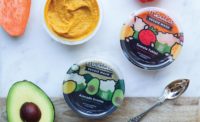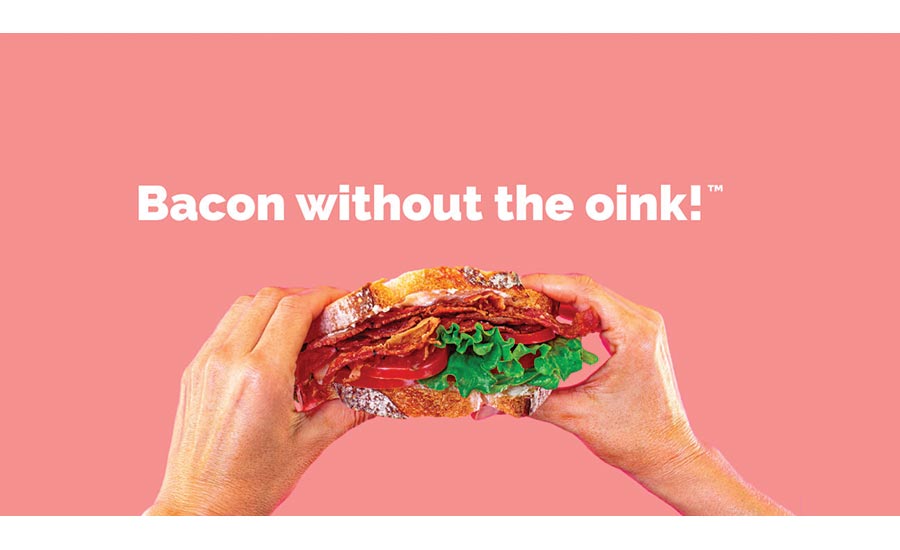Brave New World: Plant-Based Eating Reaches Global Phenomenon Status
The Innova Consumer Survey 2020 showed the top four reasons for considering plant-based alternatives were health, followed by variety, sustainability and taste

Instead of using dairy alternatives like nuts or pea protein to mimic texture, Brave Robot uses Perfect Day’s non-animal whey protein, identical to the whey protein found in cow’s milk.
PHOTO COURTESY OF: THE URGENT COMPANY (WWW.BRAVEROBOT.CO)

Atlast Food Co. and MyEat target 2021 debut of MyBacon, a new mushroom-based, meatless option with only six ingredients.
PHOTO COURTESY OF: ATLAST FOOD CO (WWW.ATLASTFOOD.CO)

Eat Just, Inc. announced the first commercial sale of GOOD Meat Cultured Chicken, meat created directly from animal cells for human consumption. It was served in mid-December at 1880, a restaurant in Singapore.
PHOTO COURTESY OF: EAT JUST INC. (WWW.GDMEAT.COM)

December saw Chobani expand its oat products portfolio. One new offering is Chobani Oat Zero Sugar, a new vegan-friendly drink with 0g of sugar and no lactose, nuts or gluten.
PHOTO COURTESY OF: CHOBANI LLC (WWW.CHOBANI.COM)

Gathered Foods goes beyond plant-based tuna. This summer, it also will bring its Wicked Foods plant-based entree line over to the US from the UK.
PHOTO COURTESY OF: GATHERED FOODS (WWW.GOODCATCH.COM)





It’s clear that the plant-based revolution rolls on and continues to evolve. And not only has it reached mainstream status—but now it might be described as a global phenomenon.
Interest in plant-based eating has been developing for some time. Innova Market Insights identified plant-based eating as a “disruptor” in conjunction with its Top Ten Trends for 2017. Fueling this well-documented boom has been growing popularity of flexitarian diets. Looking back, there had been a relatively small percentage of consumers preferring plant-based products and identifying themselves as strictly vegan or vegetarian (avoiding animal products for ethical reasons). However, there simply are more consumers overall (including meat lovers) for whom plant-based products now appeal as healthier and “cleaner.”
In 2019, Innova’s Top Ten Trends also included “Plant Kingdom.” That year saw a rapid move toward the mainstream as more consumers turned away from an all-or-nothing way of eating and instead pursued a healthy, sustainable balance between meat and vegetables. As a result, brands started to “green up” their portfolios for the mainstream consumers who wanted to add more plant-based options.
In 2020, “The Plant Based Revolution” also featured in Innova’s Top Trends ranking, as plant based innovation continued to flourish. Entering last year, consumers expressed interest in health, sustainability and ethics and all of these were increasingly tied into the broader consumer lifestyle trend towards cleaner living. As the use of the term “plant-based” moved more into the mainstream, the industry (often led by start-up companies) increasingly took up the challenge to deliver more clean label meat and dairy alternatives with improved nutritional profiles.
Looking ahead to 2021, plant-based eating is at the fore again, with “Plant-Forward” also named as one of Innova’s Top Ten Trends for this new year. It highlights the rising appeal of plant-based products in different regions and categories as consumers demand new formats, new plant proteins and new levels of sophistication.
The Innova Consumer Survey 2020 showed the top four reasons for considering plant-based alternatives were health, followed by variety, sustainability and taste. Meanwhile, a look at on-pack labeling shows plant-based claims increasingly in evidence alongside more established vegetarian and vegan positionings.
According to Innova Market Insights data, the emerging use of plant-based claims for global food and beverage launches had a CAGR of 57% from 2015 to 2019, compared with 22% for on-trend vegan positionings and a more modest 8% for the more mainstream and established vegetarian category.
Research in 2019 also indicated that 58% of consumers preferred plant-based claims when buying alternatives to meat and/or dairy. The use of more specific plant protein claims also is booming, with a CAGR of 46% from 2015 to 2019. Here, it’s evident that protein from plants is increasingly and more prominently presented as a key product feature and terms such as “plant power” are more commonly used.
Speaking of plant power, these claims and products are everywhere. Fast-food restaurants have augmented menu offerings with plant-based meat sandwiches such as Impossible Foods’ Impossible Burger and Beyond Meats’ Beyond Burger. Meanwhile, there’s been growing competition in the supermarket case with new meat alternatives from giants such as Tyson Foods (Raised & Rooted) Kellogg’s (Morningstar Incogmeato), Hormel Foods (Happy Little Plants) and JBS USA (Planterra Foods / Ozo).
Looking ahead, key challenges in the plant-based sector still involve clean label and sustainable options, ingredient simplicity, minimal processing and the optimization of taste and textural experiences. In particular, ingredient simplicity and minimal processing are important. It’s clear that consumers prefer a few simple, plant-based ingredients over artificial components.
Developing Non-Dairy
Perhaps not surprisingly, major dairy brands such as Chobani LLC, Norwich, N.Y., and Danone North America, White Plains, N.Y., are among those leading new product development of non-dairy alternatives.
Chobani introduced oat-based products as it closed out 2019. This line now encompasses plain and flavored milks, flavored coffee creamer and a range of yogurts, including mix-in split packs. In July 2020, it came back with Chobani Probiotic, a range of functional style, plant-based beverages. The oat and fruit juice base is fermented with a blend of probiotic cultures to support digestive and immune health. Four flavors include Lemon-Ginger, Pineapple Turmeric, Peach Mint and Cherry Hibiscus Tea.
Early 2020 saw Danone extend its popular Activia probiotic line with plant-based dairy-free yogurts made with almond milk. Its line includes such flavors as Peach Hibiscus, Raspberry Pomegranate, Blueberry Açai and Vanilla Cinnamon. Danone also launched plant-based options across its wider dairy brand portfolio. Just in yogurts alone, these new options included Dannon Light & Fit Good Plants vegan yogurts and a coconut milk version of its popular Oikos Greek yogurt.
Of course, Danone already has an established and market-leading range of plant-based yogurts in the US, with well-established brands such as Silk and So Delicious that came with the purchase of WhiteWave in 2016. In preparation for an expected run on plant-based dairy alternatives, Danone also opened North America’s largest plant-based yogurt production facility in 2019, with the goal of tripling its overall plant-based business by 2025.
While non-dairy spoonable yogurt remains a very small market globally in comparison with its dairy counterpart, it is seeing very strong growth. Its share of dairy launches rose from less than 0.5% in 2012 to 1.7% in 2019 and to 2.3% in the 12 months to the end of March 2020. This share more than doubles to more than 5% in the highly developed US market, however, reflecting the strength of plant-based and dairy free alternatives in the country overall. NPD growth in North America overall has been very strong in recent years as interest has accelerated. During the 2015 to 2019 period the CAGR of 32.6% for non-dairy spoonable yogurt far outperformed the dairy category growth figure of just under 8%.
For the record, the US also has experienced a surge of other non-dairy offerings across all categories –including butter, cheese, milk and frozen desserts. Two new plant-based milk alternatives hail from PANOS Brands LLC and Koita Foods, companies that both have ties to Italy. PANOS, Rochelle Park, N.J., introduced five organic varieties of Better Than Milk—including Unsweetened Almond Drink, Almond Drink, Unsweetened Oat Drink, Unsweetened Rice + Calcium Drink, and Rice Hazelnut Drink. Meanwhile, Koita Foods’ namesake shelf-stable line also includes six options: Organic Almond, Oat, Soy, Soy for Coffee, Rice and Organic Coconut.
Other noteworthy new plant-based milks hail from Chile’s NotCo, which launched NotMilk in Whole Foods Market stores nationwide. EVR Foods, Aiken, S.C., also branched out of plant-based yogurts and into milks with its Lavva plant-based foods brand (formulated with Pili nuts). Also extending its technology forward was Perfect Day, the Emeryville, Calif., firm that developed a non-animal whey protein. Perfect Day launched a spinoff, The Urgent Co., to introduce Brave Robot animal-free dairy ice cream. Meanwhile, Perfect Day also has partnered with others, such as Cincinnati’s Graeter’s Ice Cream, to introduce Perfect Indulgence, also an animal-free frozen dessert.
Meat The Next Generation
Novel vegan meat replacements—made entirely from plants—also have become more sophisticated in recent years. Most importantly, the latest new offerings’ taste and consistency more closely resembles meat than did previous classic vegan and vegetarian replacements. This is primarily because of new technologies developed by companies such as Beyond Meat (blending plant-based ingredients) and Impossible Foods (highlighting plant-based heme, the fermentation of genetically engineered yeast). The companies began in 2009 and 2011 respectively and started launching new products from 2013 to 2016. Since then, both have established worldwide sales in both the foodservice and retail sectors.
Another global powerhouse, Nestlé SA, made a major move into the meat-free market with a new “cook-from-raw” plant-based burger introduced in Europe in 2019. Garden Gourmet Incredible Burgers debuted as 100% plant based with natural protein from soy and wheat, plus natural plant extracts (beetroot, carrot and bell pepper). All these ingredients worked together to simulate the look of a beef burger before, during and after cooking. Nestlé was forced to rename the product as a Garden Gourmet Sensational Burger in mid-2020 after courts ruled that the original name infringed upon Impossible Foods’ trademarks. The Sensational line also now encompasses sausages, mince and chorizo products.
In 2017, Nestlé USA entered the US plant-based market when it acquired Sweet Earth Foods, Moss Landing, Calif. In fall 2019, it launched the Sweet Earth Awesome Burger (primarily showcasing pea protein) and Awesome Grounds for supermarket retail sales. More recently, the US business has even incorporated meatless crumbles ingredients in sister brand offerings—including Stouffer’s entrees (as a meatless lasagna filling alternative) and DiGiorno pizza (as a meatless sausage pizza topping). Fall 2020 also saw Nestlé Professional extend the Awesome burger product line to college campus offerings.
After 10 years of developing its plant-based beef substitutes, Impossible Foods extended its line with Impossible Pork and Impossible Sausage. They debuted at CES tech show in Las Vegas in early 2020 and also earned a spot in Time magazine’s 100 Best Inventions in 2020. Last September, the company also went global by offering Impossible Sausage in Starbucks outlets in Hong Kong. About the same time, the Impossible Burger debuted in Canada.
Meatless options continue to abound in every form and in every direction. A popular favorite—bacon—was a target of meat-free processors Hooray Foods, San Francisco, and Atlast Food Company, Albany, N.Y. Hooray Foods’ meat-free bacon is made from coconut oil, rice flour, tapioca starch, liquid smoke, umami seasoning (shiitake mushrooms, salt, mushroom extract, calcium carbonate), maple syrup, salt and beet juice concentrate. For its part, Atlast is eyeing a 2021 rollout for its new MyBacon product, which only has six ingredients, focused mainly around mushroom mycelium (foundational fungi).
Plant-based seafood options also continue to expand thanks to specialist companies such as Gathered Foods, New York, N.Y. The company debuted in 2017 with a line of plant-based tuna offerings. Last year, it opened its 42,500-sq.-ft. production plant in Heath, Ohio, and bolstered its line with frozen New England Style Plant-Based Crab Cakes, Thai Style Plant-Based Fish Cakes, and Classic Style Plant-Based Fish Burgers.
Emerging Options
As more consumers power up on plant protein, it presents more industry opportunities and challenges particularly with regard to regional preferences and expectations around sustainability. Looking forward, a wider variety of alternatives are expected to disrupt the segment using a wider variety of ingredients.
It has also been suggested that there are opportunities for plant and animal protein blends, mixing whey and vegetable protein in sports nutrition products, for example, or dairy and plant milks for beverages, or meat and vegetable components for burgers. An Innova Consumer Survey indicated that a leading 35% of consumers would prefer a mix of plant and animal products, while 22% would prefer 100% plant-based options.
Laboratory-grown food development also is a potential way forward to more sustainable farming. Interestingly, the term “labriculture” is entering popular nomenclature and is referring to slaughter-free technologies of cellular agriculture, cited as an avenue for sustainable meat consumption. Dairy proteins produced through fermentation (Perfect Day) rather than by cows also are starting to appear. Also under discussion is the potential for “air-based foods” made from air and electricity.
Lab-grown foods have the potential to disrupt the industry by mainstreaming the use of new technologies. Laboratory grown “chicken meat” for example, won approval from Singapore’s regulators at the end of 2020, allowing the sale of “chicken bites” made by developing cells derived from a live animal in a bioreactor fed with nutrients. The decision paves the way for lab-grown meat to be sold around the world and, although it is not vegetarian or vegan, it does not involve animal slaughter and does overcome some of the environmental, ethical and animal welfare concerns around traditional produced meat.
Eat Just Inc., the San Francisco firm known for its JUST egg alternative, developed GOOD Meat Cultured Chicken and is credited for the first commercial sale of meat created directly from animal cells for human consumption. It was to be menued in late December in the Singapore restaurant, 1880.
Targeting a 2021 debut is San Diego’s BlueNalu, Inc., which has spent the past four years, since 2017, developing cell-based finfish including mahi mahi, red snapper, tuna, and yellowtail. Last year saw the company move to a larger 38,000-sq.-ft. facility including a pilot-scale food production plant, kitchen and demonstration space.
Looking for a reprint of this article?
From high-res PDFs to custom plaques, order your copy today!










